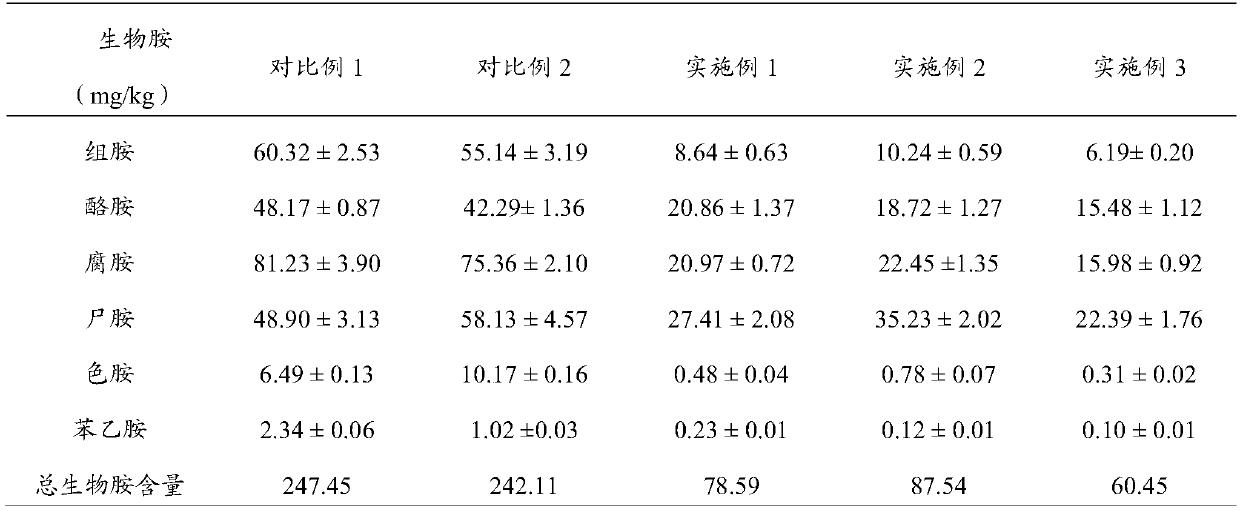Lactobacillus plantarum Yc-5 and application thereof to reduction of content of Yucha biogenic amine
A technology of Lactobacillus plantarum and biogenic amines, which is applied in microorganism-based methods, microorganisms, microorganisms, etc., can solve the problems of loss of nutrients, few types of biogenic amines, poor degradation effect, etc., and achieves wide application prospects and reduces biogenic amines. The effect of content
- Summary
- Abstract
- Description
- Claims
- Application Information
AI Technical Summary
Problems solved by technology
Method used
Image
Examples
Embodiment 1
[0033] Utilize the method for plantaractobacillus Yc-5 (CGMCC No.16615) to reduce the biogenic amine content of fish tea, comprising steps:
[0034] S1. Raw material pretreatment:
[0035] For fresh grass carp, remove the head, tail, fishbone and viscera, cut the fish meat into small pieces of 2cm×2cm×2cm; soak the fish pieces in saturated salt water at 10°C for 1.5h, drain and set aside;
[0036]The rice is cleaned, the weight ratio of the rice to water is 1:1.5, heated at 100° C. for 30 minutes to obtain rice, and cooled for later use;
[0037] S2. Making fish tea:
[0038] Clean the container and sterilize at 121°C for 20 minutes; take 210g of rice, 70g of fish pieces obtained in step S1 and 3.5g of 10 7 Mix the CFU / mL Lactobacillus plantarum Yc-5 bacterial solution evenly, place it in the container, and leave it sealed at 23°C for 35 days to ferment to obtain fish tea;
[0039] Wherein, the preparation method of the Lactobacillus plantarum Yc-5 bacterial liquid is as fo...
Embodiment 2
[0041] Utilize the method for plantaractobacillus Yc-5 (CGMCC No.16615) to reduce the biogenic amine content of fish tea, comprising steps:
[0042] S1. Raw material pretreatment:
[0043] For fresh carp, remove the head, tail, fishbone and viscera, cut the fish meat into small pieces of 2cm×2cm×2cm; soak the fish pieces in saturated salt water at 15°C for 1 hour, drain and set aside;
[0044] The rice is cleaned, the weight ratio of the rice to water is 1:1.5, heated at 100° C. for 30 minutes to obtain rice, and cooled for later use;
[0045] S2. Making fish tea:
[0046] Clean the container and sterilize at 121°C for 20 minutes; take 140g of rice, 140g of fish pieces obtained in step S1 and 1.4g of 10 8 Mix the CFU / mL Lactobacillus plantarum Yc-5 bacterial solution evenly, place it in the container, and leave it sealed at 20°C for 37 days to ferment to obtain fish tea;
[0047] Wherein, the preparation method of the Lactobacillus plantarum Yc-5 bacterial liquid is as foll...
Embodiment 3
[0049] Utilize the method for plantaractobacillus Yc-5 (CGMCC No.16615) to reduce the biogenic amine content of fish tea, comprising steps:
[0050] S1. Raw material pretreatment:
[0051] For fresh bighead carp, remove the head, tail, fishbone and viscera, cut the fish meat into small pieces of 2cm×2cm×2cm; soak the fish pieces in saturated salt water at 4°C for 3 hours, drain and set aside;
[0052] The rice is cleaned, the weight ratio of the rice to water is 1:1.5, heated at 100° C. for 30 minutes to obtain rice, and cooled for later use;
[0053] S2. Making fish tea:
[0054] Clean the container and sterilize at 121°C for 20 minutes; take 320g rice, 80g fish nuggets obtained in step S1 and 8g10 6 Mix the CFU / mL Lactobacillus plantarum Yc-5 liquid evenly, place it in the container, and leave it sealed at 25°C for 32 days to ferment to obtain fish tea;
[0055] The preparation method of the Lactobacillus plantarum Yc-5 bacterial liquid is as follows: Streak the Lactobaci...
PUM
 Login to View More
Login to View More Abstract
Description
Claims
Application Information
 Login to View More
Login to View More - R&D
- Intellectual Property
- Life Sciences
- Materials
- Tech Scout
- Unparalleled Data Quality
- Higher Quality Content
- 60% Fewer Hallucinations
Browse by: Latest US Patents, China's latest patents, Technical Efficacy Thesaurus, Application Domain, Technology Topic, Popular Technical Reports.
© 2025 PatSnap. All rights reserved.Legal|Privacy policy|Modern Slavery Act Transparency Statement|Sitemap|About US| Contact US: help@patsnap.com

